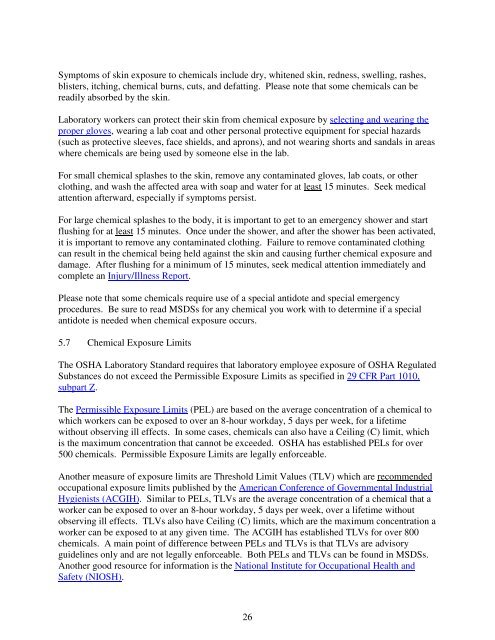Chemical Hygiene Plan - Queensborough Community College ...
Chemical Hygiene Plan - Queensborough Community College ...
Chemical Hygiene Plan - Queensborough Community College ...
Create successful ePaper yourself
Turn your PDF publications into a flip-book with our unique Google optimized e-Paper software.
Symptoms of skin exposure to chemicals include dry, whitened skin, redness, swelling, rashes,<br />
blisters, itching, chemical burns, cuts, and defatting. Please note that some chemicals can be<br />
readily absorbed by the skin.<br />
Laboratory workers can protect their skin from chemical exposure by selecting and wearing the<br />
proper gloves, wearing a lab coat and other personal protective equipment for special hazards<br />
(such as protective sleeves, face shields, and aprons), and not wearing shorts and sandals in areas<br />
where chemicals are being used by someone else in the lab.<br />
For small chemical splashes to the skin, remove any contaminated gloves, lab coats, or other<br />
clothing, and wash the affected area with soap and water for at least 15 minutes. Seek medical<br />
attention afterward, especially if symptoms persist.<br />
For large chemical splashes to the body, it is important to get to an emergency shower and start<br />
flushing for at least 15 minutes. Once under the shower, and after the shower has been activated,<br />
it is important to remove any contaminated clothing. Failure to remove contaminated clothing<br />
can result in the chemical being held against the skin and causing further chemical exposure and<br />
damage. After flushing for a minimum of 15 minutes, seek medical attention immediately and<br />
complete an Injury/Illness Report.<br />
Please note that some chemicals require use of a special antidote and special emergency<br />
procedures. Be sure to read MSDSs for any chemical you work with to determine if a special<br />
antidote is needed when chemical exposure occurs.<br />
5.7 <strong>Chemical</strong> Exposure Limits<br />
The OSHA Laboratory Standard requires that laboratory employee exposure of OSHA Regulated<br />
Substances do not exceed the Permissible Exposure Limits as specified in 29 CFR Part 1010,<br />
subpart Z.<br />
The Permissible Exposure Limits (PEL) are based on the average concentration of a chemical to<br />
which workers can be exposed to over an 8-hour workday, 5 days per week, for a lifetime<br />
without observing ill effects. In some cases, chemicals can also have a Ceiling (C) limit, which<br />
is the maximum concentration that cannot be exceeded. OSHA has established PELs for over<br />
500 chemicals. Permissible Exposure Limits are legally enforceable.<br />
Another measure of exposure limits are Threshold Limit Values (TLV) which are recommended<br />
occupational exposure limits published by the American Conference of Governmental Industrial<br />
Hygienists (ACGIH). Similar to PELs, TLVs are the average concentration of a chemical that a<br />
worker can be exposed to over an 8-hour workday, 5 days per week, over a lifetime without<br />
observing ill effects. TLVs also have Ceiling (C) limits, which are the maximum concentration a<br />
worker can be exposed to at any given time. The ACGIH has established TLVs for over 800<br />
chemicals. A main point of difference between PELs and TLVs is that TLVs are advisory<br />
guidelines only and are not legally enforceable. Both PELs and TLVs can be found in MSDSs.<br />
Another good resource for information is the National Institute for Occupational Health and<br />
Safety (NIOSH).<br />
26
















